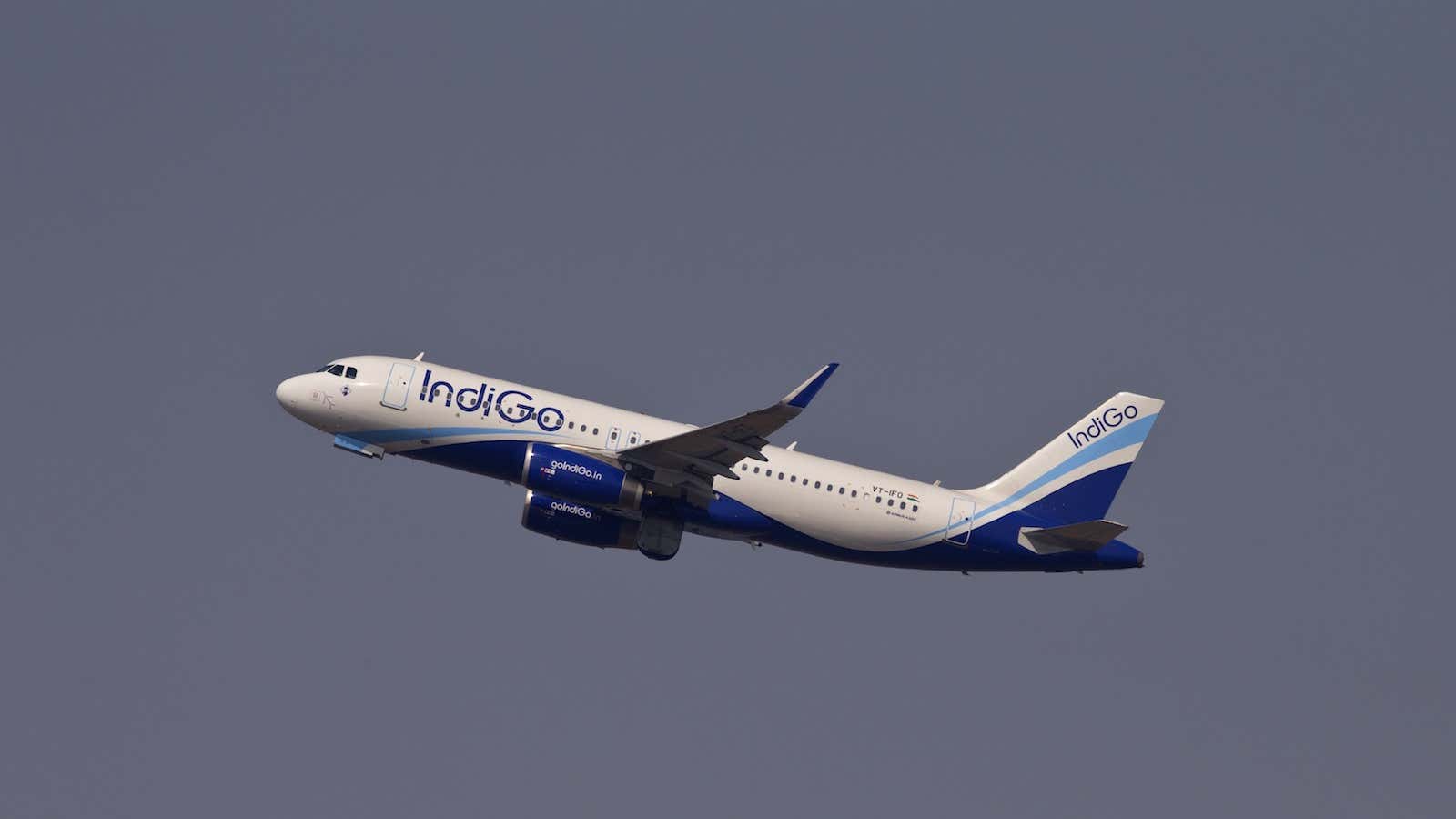India’s biggest airline is going public.
After years of speculation, InterGlobe Aviation, which operates IndiGo—India’s largest airline by market share—filed its draft red herring prospectus (DRHP) with the Securities and Exchange Board of India (SEBI), the country’s capital markets regulator, on June 30.
InterGlobe will issue fresh capital of up to Rs1,273 crore ($200 million) and offer to sell up to 30,146,000 equity shares held by a few existing shareholders, it said in a statement. This would be the the largest public share sale by an Indian airline.
The company, Reuters reported, is expected to raise around Rs2,546 crore ($400 million) through this initial public offering (IPO). The proceeds are likely to be used for the expansion of its fleet, reduce debt and purchase ground support equipment, according to the prospectus.
Star performer
For the last decade, IndiGo has been a standout performer in India’s turbulent aviation industry.
Even as the industry was roiled by a raft of problems—high debt, increasing fuel costs, overcapacity and growing competitors—the low-cost carrier consistently posted profits over the past few years.
It is one of the only two airlines in India that made a profit in the 2015 financial year, according to estimates from the Centre for Asia Pacific Aviation India (CAPA India), an aviation consultancy firm. The other is GoAir.
Over the last few years, here’s how the low-cost carrier performed.
Domestic traffic in the country increased 13.9% year-on-year for the 2015 financial year, according to CAPA India. That helped IndiGo increase its market share to 36.4%.
IndiGo also benefits from its strategic sale-and-leaseback model for its fleet, which is entirely comprised of Airbus aircrafts.
“We generally assign our right to purchase each aircraft under our purchase agreement with Airbus to a third-party lessor and lease the aircraft from the lessor following delivery of the aircraft under a sale-and-leaseback agreement,” the company said in the DRHP.
These agreements, which range from between three and six years, keep the fleet size young—and operations efficient. IndiGo has an average fleet of 3.6 years, as of April 2015, which is one of the youngest among low-cost carriers globally.
“Our advantage is we get a fresh product with a newer technology, less fuel burn, less carbon footprint, latest safety standard,” Aditya Ghosh, president of IndiGo, said in 2013. “While for someone who flies an aircraft for many years because it is on their books, it is like driving a M800 that was new in 1985 when you bought it but gets older and older with every passing year, versus someone who brings in a new M800 every year.”
The founders
IndiGo was founded by Rahul Bhatia—an electrical engineer from Canada’s University of Waterloo—and Rakesh Gangwal, a former chairman of US Airways. Bhatia’s InterGlobe Enterprises owns a 51% stake in the company, while Gangwal’s Virginia-based Caleum Investments holds a 48% interest. Educated at the Indian Institute of Technology, Kanpur and Wharton Business School, Gangwal began has career at Ford before moving into the aviation sector.
Bhatia set up InterGlobe as an air transport company in 1989. By 1994, it bagged the India franchise rights for Galileo International, an airline reservation system once owned by United Airlines, and much of his friendship with Gangwal—who was earlier with United Airlines—was developed during this period.
In 2014, while speaking about the company’s early years, Bhatia said, “Gangwal was hesitant because of the high mortality rate in the business.”
“But I’m a persistent guy,” the 55-year-old added.
In 2005, IndiGo placed an order with Airbus to buy 100 aircrafts, and started operations in August 2006. By 2008, the company hired Aditya Ghosh, a 39-year-old Delhi University-trained lawyer, to head its operations in India. Today, IndiGo has 180 aircrafts on order with Airbus and operates 97 aircrafts in the country.
“Their promoters understand the business very well,” Dhiraj Mathur, executive director at consultancy firm PwC, said in an interview to CNBC. “They have got their model working. They created the low-cost model in the country and they have been running it very well and efficiently. So, it is not as if the market has favoured them, they have been able to understand what it takes to make money.”
The IPO
Already the ninth largest aviation market globally, domestic air travel in India is likely to grow at an annual rate of 9.5% between 2011 and 2031, according to Airbus. That’ll make India one of the fastest growing airline markets in the world.
“Looking at the long run, this is a very promising sector in India,” Mathur of PwC said. “It is a highly underserved market, I would say less than 3% of our population flies. We have something like one plane per two million population whereas the US has something like one plane per 50,000.”
In fact, in 2012, India had 0.07 airline seats per capita, compared to 2.49 in the US and 0.29 in China.
That means there’s plenty of room for growth for the likes of IndiGo even in an increasingly competitive market like India, where two new players—Vistara and Air Pegasus—launched services in 2015.
And it helps that oil prices have eased. The losses in the airline industry, CAPA estimates, will come down substantially by almost 40% this year, as oil prices tumble. At IndiGo, for instance, fuel costs comprise over 40% of all expenses, so any softening in oil price will have an impact.
“IndiGo’s IPO will be the first big listing after Jet Airways’ 2005 IPO,” Kapil Kaul, chief executive officer (South Asia) at CAPA, said. ”I expect IndiGo’s IPO to bring retail investors back to the airline sector. Airline IPOs since 1990s have hurt investors, especially small investors, significantly, and IndiGo’s IPO is expected to restore confidence.”
